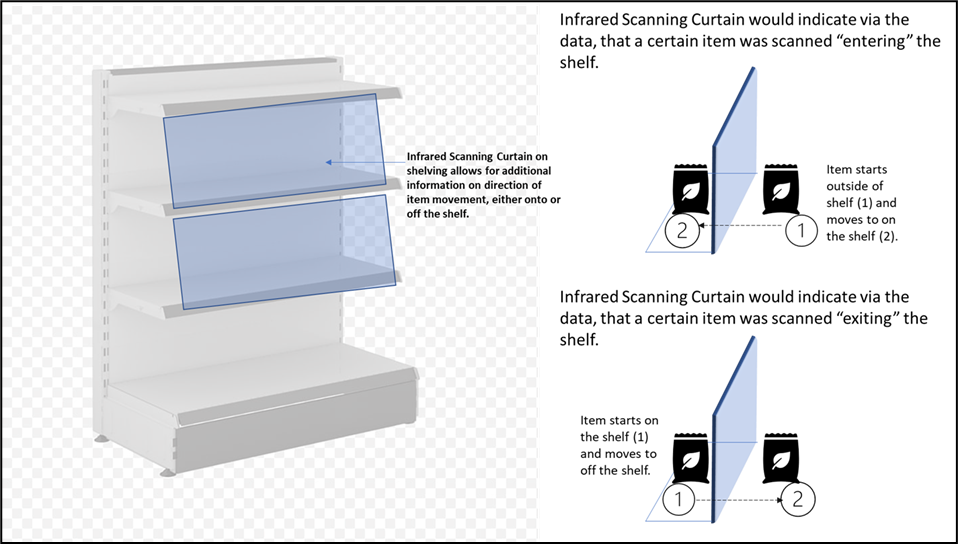Authors:
John Pistone, Kristen Chung, Ted Clark, Kirk Goldman, Manda Miller, Brian Taylor
Abstract:
This invention utilizes an infrared curtain or barrier on shelving to monitor if items are “entering” the shelf or “exiting” the shelf. The curtain is set up in such a way that how an item passes through the infrared curtain helps determine if the item is going on the shelf or being pulled off the shelf.
This invention could be paired with camera vision and a mobile app to also track shopper behavior, so that the retailer can deliver coupons or promotions to the shopper that was moving the item.
Background:
Throughout the store items are scanned, either for stocking purposes and/or for purchasing. When items are scanned for stocking purposes, they are usually scanned to indicate that they are received and then taken to the aisles and stocked on the shelves. A shopper then takes the item off the shelf and purchases it by scanning the item and paying for it through a checkout process.
Scanning allows for the retailer to get some sort of inventory data and how much of an item has been received, stocked, and sold. It also helps to calculate shrink (item received but was never sold however it is not there or accounted for).
This scanning though is not sufficient, as a scan doesn’t actually show the movement of the product. For example, the retailer may know that the item was scanned as it was received from shipment, but there is no scanning data to validate that the item was put on the shelf. Our invention would solve this problem by indicating, based on the movement through the shelf infrared curtain, that the item was placed on the shelf. Another problem that occurs is when shoppers move items from one place to another. Even though an item was placed on a different shelf, our invention would show that the item left a shelf, and was placed back on another shelf, keeping inventory numbers accurate and preventing unnecessary purchasing of additional stock. Also, if the item was removed from the shelf and there was no purchase data, and it was not placed back on the shelf, then you could get more accurate shrink data, as the item may have been stolen or thrown out.
Camera vision has also played a role in understanding movement of items. Camera Vision is expensive and requires lots of cameras to cover space and shelving. This invention would be able to keep track of inventory without cameras. However, Camera Vision could be a complement to this invention and paired with consumer mobile app to help deliver promotions to customers and to aid in frictionless shopping
Description:
The novelty of the main idea is the ability of an infrared shelf scanning curtain to give context on whether an item entered or exited a shelf. This context would then be reflected in inventory data.

Usages:
Accurate inventory shelf counting: Data would indicate number of Item X that entered the shelf vs number of Item X that exited the shelf
Accurate inventory shelf counting could be compared to other indicators such as number of Item X that were purchased at the POS or number of Item X that were scanned upon delivery of shipment from the vendor.
Enabling Technology:
Infrared barcode
Bidirectional infrared curtain
TGCS Reference 2701









